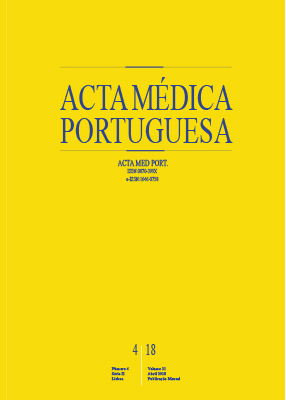Mediterranean Spotted Fever in Children: Study of a Portuguese Endemic Region
DOI:
https://doi.org/10.20344/amp.9713Keywords:
Boutonneuse Fever, Child, Exanthema, Portugal, RickettsiaAbstract
Introduction: Mediterranean spotted fever is an infectious disease included in the human rickettsiosis group, with its main distribution in the Mediterranean and South European countries. It is an endemic disease in Portugal, with dogs acting as the main domestic reservoir. Children are a particularly vulnerable group due to their close contact with household animals and by frequently playing outdoors. In this study, we aim to describe the local epidemiology and characterize the clinical features and treatment options in a Portuguese endemic region.
Materials and Methods: We performed a prospective descriptive study of the Mediterranean spotted fever cases admitted to the paediatrics emergency department of a of a group II hospital, between January 1st 2013 and December 31st 2015. All patients were examined by a physician, who was later asked to fill out a detailed questionnaire regarding clinical presentation, diagnostic attitudes and treatment of their patients. Parents were later interviewed and questioned about post-discharge disease evolution.
Results: We registered 32 cases (93.9% reported between July and October). After fever, the most frequent reported symptoms were myalgia (37.5%), abdominal pain (25%) and headache (25%). Exanthema was present in 84.4% of cases by the third day of fever:
maculonodular (53.1%), papular (37.5%) and macular (9.4%). Eschars were found in 59% of patients, with regional lymphadenopathy
present in 46.9% of cases. Azithromycin (84.4%) and doxycycline (15.5%) were the selected treatments in our population, with no cases of therapeutic failure or side-effects reported.
Conclusion: The incidence of Mediterranean spotted fever is higher in our population in comparison with the rest of the country. Fever, myalgia, abdominal pain and headache were the most common presenting symptoms, while exanthema was the predominant cutaneous finding. Azithromycin was the preferred treatment and it proved to be successful and safe in all cases.
Downloads
Downloads
Published
How to Cite
Issue
Section
License
All the articles published in the AMP are open access and comply with the requirements of funding agencies or academic institutions. The AMP is governed by the terms of the Creative Commons ‘Attribution – Non-Commercial Use - (CC-BY-NC)’ license, regarding the use by third parties.
It is the author’s responsibility to obtain approval for the reproduction of figures, tables, etc. from other publications.
Upon acceptance of an article for publication, the authors will be asked to complete the ICMJE “Copyright Liability and Copyright Sharing Statement “(http://www.actamedicaportuguesa.com/info/AMP-NormasPublicacao.pdf) and the “Declaration of Potential Conflicts of Interest” (http:// www.icmje.org/conflicts-of-interest). An e-mail will be sent to the corresponding author to acknowledge receipt of the manuscript.
After publication, the authors are authorised to make their articles available in repositories of their institutions of origin, as long as they always mention where they were published and according to the Creative Commons license.









